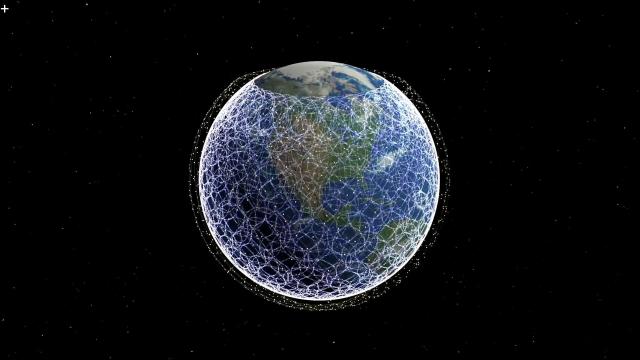Starlink satellites May harm the Ozone Layer
Starlink satellites
A University of Southern California (USC) study has recently raised questions over the possible environmental effects of internet satellite networks, such as Elon Musk’s Starlink satellites. The main concern is that these satellites may be degrading the ozone layer, which is an essential barrier that shields life on Earth from dangerous ultraviolet (UV) radiation.
According to research from the USC Department of Astronautical Engineering, an increase in low-Earth orbit satellites could cause harmful chemical reactions in the atmosphere. These satellites release a lot of aluminium oxide gas, especially the ones from SpaceX’s Starlink programme. A study that was written up in the journal Geophysical Research Letters provided more details on this discovery.

Harmful Interactions of Aluminium Oxide in the Atmosphere
When aluminium oxide is discharged into the atmosphere, it may have detrimental interactions with other atmospheric constituents. Its interaction with chlorine is a key cause for worry. Chlorine is often found in trace amounts in the atmosphere and can aid in the decomposition of ozone molecules in specific situations.
The ozone layer can be further depleted by accelerating these reactions with the addition of more aluminium oxide.
Since the ozone layer absorbs most of the sun’s harmful UV radiation, it is essential. In the absence of this shield, the Earth’s surface would be exposed to greater UV radiation, endangering species and ecosystems in addition to raising the risk of skin cancer, cataracts, and other illnesses.
Urgent Need for Addressing Satellite-Related Environmental Impacts
The USC researchers stress the urgency of the situation, given the anticipated sharp increase in the number of satellites in low-Earth orbit. To provide worldwide internet service, businesses like SpaceX intend to deploy thousands of satellites. The environmental costs must be carefully considered in addition to the significant technological gains.
Buy using this link and get the best discount on below mobile

This study draws attention to a major environmental threat that contemporary technology development poses. This highlights the significance of carrying out exhaustive environmental impact analyses before implementing extensive satellite networks.
To design policies that minimise these possible risks while still furthering technological advancement, policymakers, scientists, and industry executives must work together.
Please also read
Balancing Technological Advancement with Environmental Sustainability
In the end, this problem is a reminder that, while though the pursuit of technological advancement might have enormous positive effects, it is also crucial to explore and mitigate any potential negative effects on the environment. In order to make sure that the advancements we make today do not compromise the health of our planet or the future generations, we need to prioritise sustainable practices and creative solutions.
The Sun’s damaging ultraviolet (UV) radiation is absorbed by the ozone layer, which is vital to human survival. Food production and crop yields could be negatively impacted, and skin cancer risk could increase due to increased UV radiation exposure in the absence of this protective layer.
Low-Earth orbit internet satellites usually last five years or less. Aluminium oxides are emitted as these spacecraft burn up and reenter the atmosphere. Scientists have noted that this process may emit more than 1,000 metric tonnes of aluminium oxide per year, which would be a 646 percent increase above naturally occurring amounts. Ozone layer thinning could persist for decades due to the slow absorption of these aluminium oxide particles.

It is extremely concerning that these satellites may burn up and produce oxides of aluminium as a result. Ozone layer protection is continuously threatened by aluminium oxides because they can linger in the atmosphere for extended periods of time. Because of the ozone layer’s declining capacity to shield life on Earth from dangerous UV radiation, the continuous presence of aluminium oxides can result in ongoing chemical reactions.
Aside from having a negative influence on agriculture and food production, the increased danger of UV exposure could lead to greater rates of skin cancer.
Depletion of Ozone and an Increase in Aluminium Oxides
According to a study, the amount of aluminium oxides in the atmosphere grew by about eight times between 2016 and 2022. Forecasts indicate that if satellite launches continue, this amount might reach up to 397 metric tonnes annually, which would significantly reduce the ozone layer. 18.7 metric tonnes of aluminium oxide nanoparticles were discharged into the atmosphere by falling satellites in 2022 alone.
Launching Satellites and Concerns About Space Debris
An extra 42,000 Starlink satellites can be launched by SpaceX with authorization. Numerous other tech behemoths, including Amazon, also intend to introduce hundreds more. There are serious worries regarding space debris and ozone depletion due to the swift rise in satellite counts. There is a chance of collisions due to the growing amount of space junk, which could harm other spacecraft.
What happens if the ozone layer is destroyed?
Internet satellite networks like Elon Musk’s Starlink could destroy the ozone layer. The University of Southern California experts believe that the massive emissions of aluminium oxide gas into the atmosphere from SpaceX’s Starlink satellites could be detrimental to the ozone layer.
What does aluminum oxide do to the atmosphere?
An estimated 17 metric tonnes of aluminium oxide compounds will be produced by all of the satellites reentering the atmosphere in 2022. Mega-constellation reentry scenarios indicate an annual production of more than 360 metric tonnes of aluminium oxide compounds, which has the potential to seriously deplete the ozone layer.
Does aluminium oxide absorb moisture?
Moisture from the gas stream is absorbed by the pores in the aluminium oxide layer in proportion to the gas stream’s moisture concentration.




Pingback: Starlink Mini:Now Internet is in Your Backpack
Thank you for your appreciation! It’s always great to hear that the perspectives and insights provided are valuable to you. If you have any specific topics or questions you’d like to explore further, please let me know. I’m here to help with information, advice, or a deeper dive into any subject you’re interested in.